Rapid transit


A rapid transit, underground, subway, elevated railway or metro(politan) system is an electric passenger railway in an urban area with high capacity and frequency, and which is grade separated from other traffic.[1][2] Rapid transit systems are typically either in tunnels or elevated above street level. Outside urban centres rapid transit lines sometimes run grade separated at ground level.
Service on rapid transit systems is provided on designated lines between stations using electric multiple units on rails, although some systems use magnetic levitation or monorails. They are typically integrated with other public transport and often operated by the same public transit authorities. Rapid transit is faster and has a higher capacity than trams or light rail, but is not as fast or as far-reaching as commuter rail. It is unchallenged in its ability to transport large amounts of people quickly over short distances with little land use. Variations of rapid transit include people movers, small-scale light metro and the commuter rail hybrid S-Bahn.
The first rapid transit system was the London Underground, which opened in 1863. The technology quickly spread to other cities in Europe and then to the United States, where a number of elevated systems were built. Since then the largest growth has been in Asia and with driverless systems. More than 160 cities have rapid transit systems, totalling more than 8,000 km (4,900 miles) of track and 7,000 stations. Twenty-five cities have systems under construction.
Contents |
Terminology
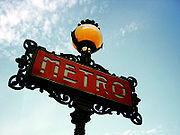
The term metro is the most common name for underground rapid transit systems[3] although in English speaking countries the terms subway[4] and underground[5] are used more often. In some cities the term subway applies to the entire system, while in others only to those parts that are actually underground.
Above-ground rapid transit systems that are above street level may be called L or Elevated (Railway), or SkyTrain,[6] or monorail when this is the system in use. Other terms for rapid transit systems are the U-Bahn,[7] T-bane[8].
History
Rapid transit has evolved from conventional railways that were developed in the late 18th century, with the first underground conventional system opened in 1804.[9] The first system opened was the London Underground in 1863, built to connect the main railway stations around the city.[10] The technology swiftly spread to other cities in Europe, and then to the United States where a number of elevated systems were built, starting in New York in 1868; this solved the problem of exhaust fumes from the steam locomotives.[11] In 1890 the City & South London Railway in London was the first user of electric traction and of deep-level tunnels.[12]

By 1940 there were 19 systems, by 1984 there were 66. This included small cities like Oslo and Marseille opening extensive systems in the 1960s. The last decade's growth of new systems has moved largely to Southeast Asia and Latin America.[7] Western Europe and North America have instead been seeing a revival of the tram through light rail systems supplementing rapid transit on new lines, with less focus on building rapid transit.[13] At the same time, technological improvements have made new lines and systems driverless. Hybrid solutions have also evolved, such as tram-train and premetro, which have rapid transit qualities on part of the system.[12]
Operation
Rapid transit is used in metropolitan areas to transport large numbers of people at high frequency. The extent of the rapid transit system varies greatly between cities, with several transport strategies; in larger metropolitan areas the underground system may extend only to the limits of the central city, or to its inner ring of suburbs with trains making frequent station stops. The outer suburbs may then be reached by a separate commuter rail network, where more widely spaced stations allow higher speeds. These trains are often more expensive, less frequent, and in some cities, operate only during rush hour periods. They may or may not meet the criteria of being a rapid transit themselves.[2]
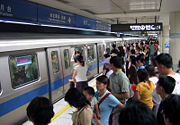
It is common for rapid transit systems to be supplemented with other systems, either buses, trams or commuter rail. Because of the high density structure of the rapid transit, short haul trips are often more easily performed with tram lines or buses. Many cities have chosen to operate a tram system in the city core with the metro expanding beyond it,[8] though many cities chose to close this system in the 1950s and 60s. Another common strategy is to use a bus or tram feeding system to transport people to the transit stops and use the transits to carry them to the city center or other bus routes. Using this system highly enhances the suburban bus system, since they are not required to drive all the way to the city center.[14]
Rapid transit systems are subject to high fixed costs, while operating costs can be smaller. Most systems are publicly owned, either through local governments, transit authorities or by national governments. Investment are often public financed, and seldom footed on the riders, but must often compete with funding for roads. The operating may be performed by the owner, or by a private company through a public service obligation. The owners of the systems normally also own the corresponding bus or other rail systems, allowing for free transfers between modes. Almost all systems operate at a deficit, requiring both fare revenue, advertising and subsidies to cover costs. Hong Kong's MTR Corporation is one of few profitable systems without subsidies.[15] However, some retain large real estate portfolios that help yield revenue[15]—some systems are even financed through sale of land after building the system to formerly low value areas.[16]
Lines
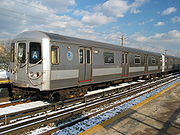
Each rapid transit system consists of one or more lines—a service that operates a particular route stopping at predetermined stations. Most systems operate several routes, and distinguished them by numbering, names and colors. The lines may share track with each other, or operate solely on their own right-of-way. The simplest solution is a fork out from a common line in the city center, used by many of the smaller systems, such as the Copenhagen Metro.[17] Another solution is to have a single central terminal (often shared with the central railway station), or the use of multiple interchange stations between lines in the city center, for instance used by the Prague Metro.[18] Some of the largest systems are so extensive that they become a large matrix, with interchanges throughout the system, even in the outer sections of the system, such as the Paris Métro[19] and the New York City Subway.[20] Some cities, such as Moscow have a loop line around the city center connecting the outward going lines.[21]
The capacity of a system for each line is a multiplication of car capacity, train length and headway. Normal length of heavy rapid transit trains is six to twelve cars, while lighter systems may use only three or four cars. Cars have a capacity of 100 to 150, varying with the seated to standing ratio — more standing gives higher capacity. Bilevel cars, used mostly only on S-Bahn type systems, allow for the higher seating needed on longer journeys. The headway between services is higher with rapid transit than mainline railways due to block signaling; the theoretical maximum being 90 seconds, but in practice limited to 120 seconds to allow for delays. Typical capacity lines allow for 1,200 people per train, giving 36,000 people per hour. The highest attained capacity is 80,000 people per hour in Hong Kong.[22]
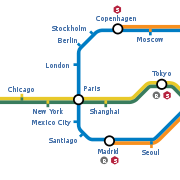
Passenger information
Rapid transit operators often have built up strong brand; in particular the use of a single letter to establish the presence of stations has become widely used, with systems identified by the letters L, M, S, T and U, among others.[3] Branding has been focused on easy recognition—to allow quick identification even in the vast array of impressions found in large cities—combined with the need to communicate speed, safety and authority.[23] In many cities, there is a single image for the entire transit authority, but the rapid transit uses its own logo that fits into the profile.
A transit map is a typological map in the form of a schematic diagram used to illustrate the routes and stations within a public transport system. The main components are color coded lines to indicate each line or service, with named icons to indicate stations. Maps may include only the rapid transit, or other modes of public transport.[24]
Transit maps can be found in the transit vehicles, at the platforms or in printed timetables. Their primary function is to help users to efficiently use the public transport system, including which stations function as interchange between lines. Unlike conventional maps, transit maps are usually not geographic accurate—instead they use straight lines and fixed angles, and often illustrate a fixed distance between stations, compressing those in the outer area of the system and expanding those close to the center.[24] Timetables are only published if frequency is so low that passengers can easily time their arrival to the station; if the headway is sufficient, the effect of there "always being a train" is achieved, and passengers will not need a timetable. This effect is normally considered reached between headways of five and ten minutes.[25]
Safety and security
As a public space, rapid transits may suffer from security problems petty crimes such as pickpocketing or baggage theft. More serious crimes may also occur, such as violence. Measures to counter incidents include use of video surveillance, security guards or conductors. In some countries a transit police may be established to enforce law on transit ground. Measures are normally integrated with those related to checking for fare validity of passengers.[26] Rapid transits have been subject to terrorism with high casualties.[27]
Compared to other modes of transport, rapid transit has a high safety record, with few accidents. Rail transport is subject to strict safety regulations, with requirements to procedure and maintenance to minimize risk. Head-on collisions are rare due to use of double track, and low operating speeds reduce the occurrence of rear-end collisions and derailment. The large use of underground sections increases the impact of fires, and systems are built to allow evacuation of trains at multiple places throughout the system.[28][29]
Infrastructure
Most rapid transit trains are electric multiple units with lengths from three to beyond ten cars.[30] Power is commonly delivered by a third rail or by overhead wires. Others use the linear motor for propulsion.[31] Most run on conventional steel railway tracks, although some use rubber tires such as the Montreal Metro. Rubber tires allow steeper gradients and a softer ride, but have higher maintenance costs and are less energy efficient. If wet or icy, rubber tires lose friction, so they cannot be used above ground in Montreal, though this is occurs other places.[32] Crew sizes have decreased throughout history with some modern systems now running completely unmanned trains.[33] Others trains continue to have drivers, even if their only role in normal operation is to open and close the doors of the trains at stations.
Variations
Underground tunnels represent a unique way to move transport systems away from the street level, allowing more ground to be allocated to buildings or other purposes. In areas with high land value or with dense land use tunnels may be the only way to feed sufficient people into the area. Cut-and-cover tunnels are constructed by digging up city streets, which are then rebuilt over the tunnel; alternatively tunnel-boring machines can be used to dig deep-bore tunnels that lay further down in bedrock.[12]
.
At-grade systems are used only outside dense areas, since they create a physical barrier that hinders flow of people and vehicle across their path. This method of construction is the cheapest, as long as land values are low. This method is often used for constructing new systems into areas that will fill up with buildings after the completion of the line, for instance when creating new suburbs.[16]
Elevated railways are a cheap and easy way to build an exclusive right-of-way without digging expensive tunnels or the barriers at-grade systems create. They were popular around the beginning of the 20th century, but fell out of favor, though returning in the last quarter of the century—often in combination with driverless systems, for instance the London Docklands Light Railway[34] and the Bangkok Skytrain.[35]
People mover systems are special rapid transit systems serving relatively small areas such as airports, downtown districts or theme park, either as independent systems or as shuttle services for other transport hubs. They are driverless and normally elevated. Monorails have been built as both conventional rapid transits or as people movers, and must be either elevated or underground. Monorail technology has proven difficult to commercialize and their use has been limited. The Berlin M-Bahn is the only commercial maglev rapid transit to operate, but has been closed.[36]
Light metro is a solution used when the full quality of rapid transit is desired, but the ridership fall short of the tier. It has smaller, typically two for four-car units, runs with lower frequency and have longer distances between stations, though remains grade separated. Light metros are sometimes used as shuttles feeding into the main rapid transit system.[37]
Some systems have been built from scratch, others are former commuter rail or suburban tramway systems that have been upgraded, and often supplemented with an underground or elevated downtown section.[8]
Stations
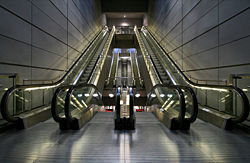
Stations function as hubs to allow passengers to board and disembark from trains. Further, stations function as payment checkpoints as well as means to change the mode of transport, for instance to bus or other rail. Access is provided either via island- or side platforms.[38] Underground station, especially deep-level ones, increase the overall transport time; long escalator rides to the platforms mean that the stations themselves can become the bottleneck of the system if not properly built. At the same time some underground stations are integrated into shopping centers, or underground access to large nearby commercial buildings.[39] In suburbs, there may be park and ride connected to the station.[40]
To allow easiest access to the trains, rapid transit has a platform height that allows for step-free access between platform and train. If the station is built in accordance with accessibility standards, it allows both disabled people and wheeled baggage easy access to the trains,[41] though a gap can exist between the train and platform on curved stations. Some stations use platform screen doors to increase safety by preventing people accidentally falling onto the tracks, as well as reducing ventilation costs.[42]

Particularly in the former Soviet Union and other Eastern European countries, but in an increasing degree other places as well, the stations were made as splendid decorations with marble walls, polished granite floors and splendid mosaics—a way to get art out to the public, reducing its isolation from normal life in galleries and museums. The systems in Moscow and St. Petersburg are widely regarded as some of the most beautiful in the world,[43] but also Stockholm has attempted to focus on art, and published an art guide and offers guide tours to the stations.[44] In addition to the pure aesthetic, beautified systems show higher passenger numbers. By using relatively small amounts on grand architecture, art, cleanliness, accessibility, lighting and a feeling of safety, systems can get larger amounts of passengers—usually the extra investments in aesthetics are profitable for the metros.[45]
Comparison
Since the 1980s modern trams have incorporated several of the advantages of rapid transit, reducing the differences between the solutions. Light rail systems run on their own right-of-way, and are not subject to congestion of other traffic; they remain at grade with other modes of transport, such as buses and cars. Some light rail systems have elevated or underground sections. Both new and upgraded tram systems allow faster speed and higher capacity, and have become an cheap alternative to construction of rapid transit, in particular in smaller cities.[13]

Premetro is a solution where an underground rapid transit solution in is built in the city center, but only a light rail system in the suburbs. Conversely, other cities have opted to build full metro standard in the suburbs, but run the trams in city streets to save the cost of expensive tunnels. In North America, interurbans were constructed as street-running suburban trams, without the grade-separation of rapid transit. Premetros can also be a solution to gradually upgrade existing tramways into rapid transit, without having to carry all the investments in one dig. They are most common in Germany with the name Stadtbahn.[46]
Commuter rail is a heavy rail system that operates at a lower frequency than rapid transit, with higher average speed often only serving one station in each village and town. Some cities have opted for a hybrid solution, with two tiers of rapid transit; a urban system (such as the Paris Métro and Berlin U-Bahn) and a suburban system with lower frequency (such as their counterparts RER or S-Bahn). The suburban systems run on their own network, but are often quite similar to commuter rail—but retain their own tracks and a high frequency, though often operated by the national railways. Some cities have built the city center sections of their national railway through tunnels in the city center; sometimes commuter trains have direct transfer to the rapid transits, on the same or adjoining platforms.[47][48]
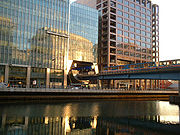
Impact
More than 160 cities have built rapid transit systems, and about twenty-five have new systems under construction.[49] Investments are high, with public financing normally required. Investment in rapid transit is sometimes seen as an alternative to building an extensive road transport system with many motorways;[50] the rapid transit system allows higher capacity with less area use and a more environmental friendly impact, at a lower cost.[51]
Some cities have built urban rail transit systems that are so comprehensive and efficient that the majority of city residents use it as their primary means of transport. This is common in many of the largest cities in Europe, such as Berlin, Paris, London, Madrid and Moscow, many large cities in Asia, such as Hong Kong, Osaka, Seoul, Taipei, and Tokyo; in North America the only city matching these is New York.[52] Tokyo is the busiest, with 7 million passengers daily.[53]
Urban planning can use elevated or underground systems in city centers to allow the transport of people without occupying expensive land, permitting the city to unfold in a compact manner without physical barriers. While construction of motorways leads to a deviation of nearby residential land value, nearness to a rapid transit station has proven a catalyst for commercial and residential growth; with large office and housing blocks being constructed in the immediate vicinity.[54][50]
Notes
- ↑ "Rapid transit". Merriam-Webster. Retrieved on 2008-02-27.; "Metro". International Association of Public Transport. Retrieved on 2008-02-27.
- ↑ 2.0 2.1 "Glossary of Transit Terminology". American Public Transportation Association. Retrieved on 2008-02-27.
- ↑ 3.0 3.1 Ström, 1998: 58
- ↑ The American Heritage Dictionary of the English Language, Fourth Edition. Houghton Mifflin Company. ISBN 0-618-08230-1.
- ↑ "Definition of "Underground"". Chambers Reference Online. Retrieved on 2006-11-28.
- ↑ Ovenden, 2007: 16
- ↑ 7.0 7.1 White, 2002: 63
- ↑ 8.0 8.1 8.2 Ovenden, 2007: 93
- ↑ "South East Wales Historical Figures". BBC. Retrieved on 2006-12-01.
- ↑ "London, England, United Kingdom". National Geographic. http://www3.nationalgeographic.com/places/cities/city_london.html. Retrieved on 2006-10-13.
- ↑ "Subway". Encyclopædia Britannica online. Retrieved on 2006-12-02.
- ↑ 12.0 12.1 12.2 Ovenden, 2007: 7
- ↑ 13.0 13.1 Pulling, Niel (2008-05-22). "Light Rail – the Solution to Inner-City Chaos?". Railway Technology. Retrieved on 2008-08-18.
- ↑ Cervero, 1998: 13
- ↑ 15.0 15.1 MTR Corporation (2008-08-05). "Announcement of Unaudited Results for the Six Months Ended 30 June 2008". Retrieved on 2008-08-21.
- ↑ 16.0 16.1 Kjenstad, 1994: 46
- ↑ Ovenden, 2007: 84
- ↑ Ovenden, 2007: 95
- ↑ Ovenden, 2007: 36–39
- ↑ Ovenden, 2007: 32–35
- ↑ Ovenden, 2007: 28–31
- ↑ White, 2002: 65–66
- ↑ Ovenden, 2007: 107
- ↑ 24.0 24.1 Ovenden, 2007: 9
- ↑ Oslo Sporveier (2005). "R2010" (in Norwegian) 4. Retrieved on 2008-08-20.
- ↑ Needle et. al., 1997: 10–13
- ↑ El Mundo. "El auto de procesamiento por el 11-M" (in Norwegian). Retrieved on 2008-09-08.
- ↑ Office of Hazardous Materials Safety. "A Comparison of Risk: Accidental Deaths - United States - 1999-2003". U.S. Department of Transportation. Retrieved on 2007-09-10.
- ↑ "Office of Rail Regulation". U.K. Health & Safety Executive. Retrieved on 2007-09-10.
- ↑ White, 2002: 64
- ↑ Sato, Yoshihiko; Matsumoto, Akira and Knothe, Klaus (2002). "Review on rail corrugation studies". Wear 253 (1–2). http://www.sciencedirect.com/science?_ob=ArticleURL&_udi=B6V5B-45Y00VJ-7&_user=10&_rdoc=1&_fmt=&_orig=search&_sort=d&view=c&_version=1&_urlVersion=0&_userid=10&md5=692937bbd448cc2810f44d44e25f9456. Retrieved on 2008-08-21.
- ↑ Société de transport de Montréal. "The Montreal Métro, a source of pride" (pdf) 6.
- ↑ Railway Technology. "Toulouse Metro, France". Retrieved on 2008-08-20.
- ↑ "Docklands Light Railway - About DLR". Retrieved on 2006-12-04.
- ↑ "Bangkok Mass Transit System Company Limited - BTS SkyTrain". Retrieved on 2006-12-04.
- ↑ Vuchic, Vukan and Casello, Jeffrey (2002). "An Evaluation of Maglev Technology and Its Comparison With High Speed Rail". Transportation Quarterly 56 (2): 33–49. http://thetransitcoalition.us/LargePDFfiles/maglev-EvalandComparisonHSR.pdf.
- ↑ White, 2002: 64–65
- ↑ Uslan et. al., 1990: 71
- ↑ Cervero, 1998: 8
- ↑ Cervero, 1998: 226
- ↑ "Dual-Mode Traction Power Distribution for Light Rail Transit: A Design Option". Transportation Research Record 1677: 67–72. 1999. ISSN 0361-1981.
- ↑ Ming-Tsun Ke, Tsung-Che Cheng and Wen-Por Wang (2002). "Numerical simulation for optimizing the design of subway environmental control system". Building and Environment 37 (11): 1139–1152.
- ↑ "Metro Arts and Architecture". Metro Bits. Retrieved on 2006-12-04.
- ↑ Storstockholms Lokaltrafik. "Konståkning i världens längsta konstutställning" (in Swedish). Retrieved on 2008-08-20.
- ↑ "10 Ways to Enhance Your Community: Unleash the Power of Public Transportation". Retrieved on 2006-12-04.
- ↑ White, 2002: 64
- ↑ White, 2002: 63–64
- ↑ Cervero, 1998: 21
- ↑ "World Metro List". Metro Bits. Retrieved on 2006-12-04.
- ↑ 50.0 50.1 Banister and Berechman, 2000: 258
- ↑ Cervero, 1998: 26
- ↑ Cervero, 1998: 20
- ↑ "Tokyo transportation fact sheet" (PDF). Web Japan. Retrieved on 2006-11-27.
- ↑ European Conference of Ministers of Transport, 2003: 187
References
- Banister, David and Berechman, Joseph (2000). Transport Investment and Economic Development. Routledge. ISBN 0419255907. http://books.google.com/books?id=g1UClQCOdE4C.
- Cervero, Robert (1998). The Transit Metropolis. Island Press. ISBN 1559635916. http://books.google.com/books?id=bLs3H_IWr3wC.
- European Conference of Ministers of Transport (2003). Safe & Sustainable Transport. Paris: OECD Publishing. ISBN 92-821-1303-5. http://books.google.com/books?id=I-Ny0W7XN6QC.
- Kjenstad, Rune (1994) (in Norwegian). På skinner i Bymarka. Oslo: Baneforlaget. ISBN 82-91448-01-9.
- Ovenden, Mark (2007). Transit Maps of the World. London: Penguin. ISBN 0-14-311265-5.
- Needle, Jerome A.; Transportation Security Board and Cobb, Renée M. (1997). Improving Transit Security. Transportation Security Board. ISBN 0309060133. http://books.google.com/books?id=WfBt0kzz524C.
- Ström, Marianne (1998). Metro Art. ACR Edition. ISBN 286770068X. http://books.google.com/books?id=cOkxz36ITdoC.
- White, Peter (2002). Public Transport: Its Planning, Management, and Operation. Taylor & Francis. ISBN 0-415-25772-7. http://books.google.com/books?id=d1oZxyjPDF4C.
- Uslan, Mark; American Foundation for the Blind, Peck, Alec; Wiener, William and Stern, Arlene (1990). Access to Mass Transit for Blind and Visually Impaired Travelers. American Foundation for the Blind. ISBN 0891281665.
- The American Heritage Dictionary of the English Language, Fourth Edition. Houghton Mifflin Company. ISBN 0-618-08230-1.
External links
 Media related to Rapid transit at Wikimedia Commons
Media related to Rapid transit at Wikimedia Commons- UrbanRail.Net, descriptions of all metro systems in the world, each with schematic maps showing all stations.
- Metro Bits Every metro of the world in fact sheets, tables, photos and feature lists.
|
||||||||||||||||||||||||||